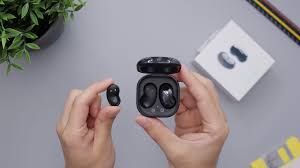The world of audio has undergone a remarkable transformation, shedding the shackles of tangled wires and ushering in an era of unparalleled freedom. For many, the terms “wireless earphones” and “true wireless earbuds” are often used interchangeably, leading to a degree of confusion. Yet, beneath the surface, subtle but significant distinctions exist, shaping our listening experiences in profound ways.
Our journey into the realm of untethered sound begins with acknowledging the inherent human desire for freedom. Just as we seek liberation in our thoughts and actions, so too do we crave it in our technological tools.
The evolution from wired headphones to wireless solutions is a testament to this innate yearning, offering not just convenience but a fundamental shift in how we interact with our digital soundscapes. Whether you’re a seasoned audiophile or a casual listener, recognizing the distinctions between these two dominant forms of wireless audio is crucial for navigating the ever-expanding market and finding the perfect sonic partner.
Wireless Earphones: The Connected Freedom
Wireless earphones, often referred to as Bluetooth earphones, represent the first major leap away from the traditional wired connection. The defining characteristic of these devices is the presence of a cable connecting the two earpieces, even though they connect wirelessly to your audio source.
This cable often features an inline remote for controlling playback, volume, and calls, and sometimes houses the battery and Bluetooth receiver. This design offers a balance between convenience and security. For instance, the connecting cable can rest comfortably around your neck when the earphones are not in use, preventing them from being easily misplaced.
The inherent design of wireless earphones provides several practical advantages. The connecting wire acts as a safeguard, reducing the risk of losing an individual earpiece, a common concern for those with a more active lifestyle.
Furthermore, this design often allows for larger batteries and components, which can translate to longer battery life and potentially better audio quality compared to their true wireless counterparts. Many users appreciate the familiarity of a physical connection between the earpieces, finding it reassuring and easy to manage, especially during workouts or commutes.
The Nuances of Neckband and Over-Ear Wireless Designs
Within the category of wireless earphones, you often encounter two primary sub-types: neckband-style and over-ear designs. Neckband wireless earphones feature a flexible band that rests around the user’s neck, with wires extending to the earpieces.
This design offers excellent stability, making them a popular choice for fitness enthusiasts and individuals who are constantly on the move. The neckband often houses the battery and controls, distributing the weight evenly and contributing to a comfortable wearing experience for extended periods.
On the other hand, some wireless earphones adopt an over-ear design, where the earpieces are connected by a wire that loops over the ear. This design can provide a more secure fit, particularly for activities that involve vigorous movement, as the wire helps to hold the earpiece in place. While less common than the neckband style, over-ear wireless earphones cater to a niche audience that prioritizes absolute stability and a discreet cable management solution.
True Wireless Earbuds: The Pinnacle of Untethered Audio
True wireless earbuds represent the zenith of wireless audio technology, offering complete freedom from wires – not just from your device, but also between the two earpieces themselves. Each earbud is an independent unit, housing its own battery, Bluetooth chip, and speaker.
They communicate wirelessly with each other and with your audio source, creating a truly unencumbered listening experience. The compact design and seamless integration into a charging case make them incredibly portable and convenient for on-the-go lifestyles. The innovation of a self-contained unit for each ear has truly revolutionized personal audio.
This radical design shift unlocks unparalleled convenience. You simply pop them into your ears, and they are ready to go. When you’re done, you store them in their charging case, which not only protects them but also recharges them, ensuring they’re always ready for your next listening session.
This level of autonomy makes true wireless earbuds an ideal companion for a wide range of activities, from intense workouts to quiet contemplation, and has spurred a significant demand for wireless earbuds in Pakistan and globally.
The Compact Power of True Wireless Charging Cases
A defining feature of true wireless earbuds is their accompanying charging case. This case is much more than just a storage solution; it’s an integral part of the true wireless ecosystem. Typically compact and pocketable, these cases house a built-in battery that charges the earbuds multiple times, extending their overall listening time significantly. The convenience of simply placing the earbuds back into their case to recharge eliminates the need for constant plugging and unplugging, streamlining the user experience.
Moreover, many modern true wireless charging cases offer additional functionalities, such as wireless charging capabilities, allowing users to simply place the case on a compatible charging mat. Some cases also feature LED indicators to display battery levels, while others integrate quick-charge technologies, providing hours of playback with just a few minutes of charging. This thoughtful design emphasizes ease of use and ensures that your true wireless earbuds are always ready when you need them.
Key Differences: Unpacking the Distinctions
The fundamental difference lies in the presence or absence of a connecting wire between the earpieces. Wireless earphones retain a physical link, offering a sense of security and often longer battery life. True wireless earbuds, on the other hand, eliminate all wires, providing ultimate freedom and portability, albeit sometimes with a trade-off in battery duration per charge. This distinction directly impacts user experience, from how they are worn to how they are stored and charged. Consider your daily habits and priorities when weighing these core differences.
Beyond the physical connection, there are also subtle differences in how these devices handle connectivity and latency. While both utilize Bluetooth, the independent nature of true wireless earbuds sometimes requires more sophisticated syncing mechanisms between the left and right earpieces. This can occasionally lead to minor latency issues in less advanced models, though modern true wireless technology has largely mitigated these concerns. The robust and often simpler connection of a single-unit wireless earphone can sometimes offer a more consistent and reliable audio stream.
Performance and Features: A Comparative Lens
When evaluating performance, several factors come into play. Battery life is a significant consideration; wireless earphones often boast longer continuous playback times due to larger batteries housed in the connecting cable or neckband. True wireless earbuds, while offering multiple charges from their case, typically have shorter individual earbud battery lives. Audio quality is another area where both categories have made significant strides, with high-fidelity codecs and active noise cancellation (ANC) becoming increasingly common. However, the form factor can influence the size of the drivers and the effectiveness of passive noise isolation.
Connectivity stability is crucial for an uninterrupted listening experience. Both types of devices rely on Bluetooth, and while modern Bluetooth versions offer excellent range and stability, the independent communication between true wireless earbuds can sometimes be more susceptible to interference in crowded environments. Comfort and fit are subjective but paramount. Many wireless earphones offer a secure fit for active use, while true wireless earbuds depend heavily on finding the right ear tip size for optimal seal and stability. The market for wireless earbuds in Pakistan is growing rapidly, with consumers increasingly looking for robust connectivity and comfortable fits.
Choosing Your Ideal Sonic Companion: A Personal Journey
The decision between wireless earphones and true wireless earbuds ultimately boils down to your individual needs, preferences, and lifestyle. If you prioritize security, extended battery life for long commutes or flights, and a slightly more robust physical presence, wireless earphones might be your perfect match. They are often a reliable choice for those who engage in moderate physical activity and appreciate the convenience of a neckband or a connecting wire for easy management.
Conversely, if absolute freedom, ultimate portability, and a minimalist aesthetic are your top priorities, true wireless earbuds are the clear winner. They are ideal for quick listening sessions, intense workouts where wires are an absolute hindrance, and for those who appreciate the discreet nature of truly untethered audio. The ease of charging and storing them in their compact case adds to their undeniable appeal, making them a popular choice for anyone seeking the most convenient and streamlined audio experience. Many users seeking cutting-edge audio technology are now opting for wireless earbuds in Pakistan that offer advanced features like active noise cancellation and personalized sound profiles. Consider the brand Login for a variety of reliable options in both categories.
Conclusion: The Future of Sound, Unbound
The evolution of wireless audio has empowered us with unprecedented freedom and convenience, transforming how we engage with our favorite sounds. Both wireless earphones and true wireless earbuds offer compelling advantages, catering to different needs and lifestyles. Wireless earphones provide a secure and familiar experience with excellent battery life, while true wireless earbuds offer the pinnacle of untethered portability and minimalist design.
As technology continues to advance, we can expect even more sophisticated features, enhanced audio quality, and longer battery lives across both categories. The choice is no longer about choosing between wired and wireless, but rather about selecting the specific form of wireless audio that best complements your unique rhythm of life. Embrace the freedom, explore the possibilities, and let your soundtrack flow unbound.



